The age of video is here, and it’s not going anywhere for a long time. Although we may not have reached the pinnacle of its growth, video content accounts for roughly 82% of all internet traffic as countless businesses have been adding it to their products and services to enhance the consumer experience.
Although the growth of video adoption is predictable, the video technology trends that define what’s most important for content producers, providers, and distributors vary year-to-year based on the needs of the market. Last year (2021), video developers around the world indicated that cost reduction, acquiring new content sources, and improving the viewing experience were top of mind. The focus on the viewing experience was reflected in the rapidly increasing adoption of Dolby Vision, Dolby Atmos, and other HDR and immersive audio formats.
However, according to our latest Video Developer Report this year we’re seeing a returned focus on back-end technical improvements. So without further ado, let’s dive into Bitmovin’s Top 4 Video Technology Trends 2022:
Video Technology Trend #1: A Shift in Business Models
As mentioned before, we’re seeing a major shift in how many businesses operate when it comes to video. The classic media industry: OTT providers, broadcast, and Telco are no longer the only video content providers, as completely new sectors have emerged in the past two years for a variety of reasons:
“In addition to the media industry, there have been a lot of new video-based applications and services popping up throughout 2019-2021. Services that focus on things like health and fitness that leverage video to reach their audience – this became especially relevant during the COVID-19 pandemic. While there are the better-known organizations, the pelotons of the world, but there are so many others that deliver content around meditation, health, sports, education, faith, or entertainment (such as concerts or theater production). All of these organizations trying to start delivering video” – Stefan Lederer @ WebSummit 2021
The streaming industry is now expected to grow to a massive $600B global market by 2025, with only roughly 60% of it being attributable to traditional TV and media models. The new focused “niche” players, such as entertainment, health & wellness, faith, and sports streamers will account for the remaining market.
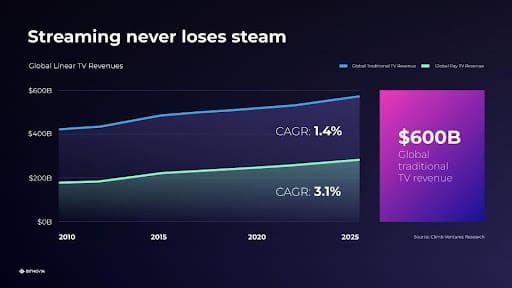
These new players have resulted in a somewhat unexpected shift in monetization models. Where the Big 5, Netflix, Disney, HBO, Amazon, Apple, have zigged by moving to a mixed model monetization model. The streaming industry as a whole is seeing a resurgence of subscription (SVOD) models. This is because most new streaming platforms start with subscriptions, as it’s easier to monetize and manage from the get-go.
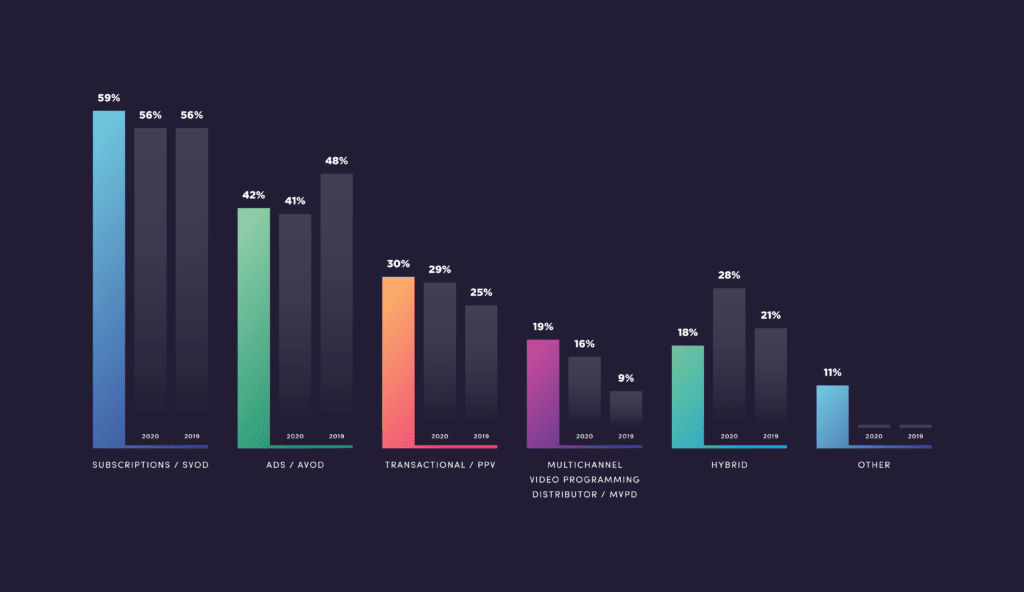
There’s less complexity in the tech build as AVOD and TVOD require significant customization to support ad insertions or pay-per-view workflows – not to mention that AVOD is based on impressions, and it’s hard to gain revenue when you don’t have significant recurring viewership.
Video Technology Trend #2: Video Codec Landscape is in for a Major Shift
Video codecs are always a hot topic in the world of video technology. Most often, folks are discussing their relative efficiency, which devices are supported, and when to adopt new ones. How quickly new codecs are ready for production can vary, and in most cases, it takes roughly 4-5 years from the time of launch to industry-wide adoption. This is largely due to the high cost of decoding relative to encoding and “device readiness” naturally lagging behind because of long hardware manufacturing cycles. Most recently, this can be seen with the AV1 codec, which is currently being utilized by 15% of respondents, but another 22% say they plan to add it this year, showing it’s at an inflection point toward major adoption.
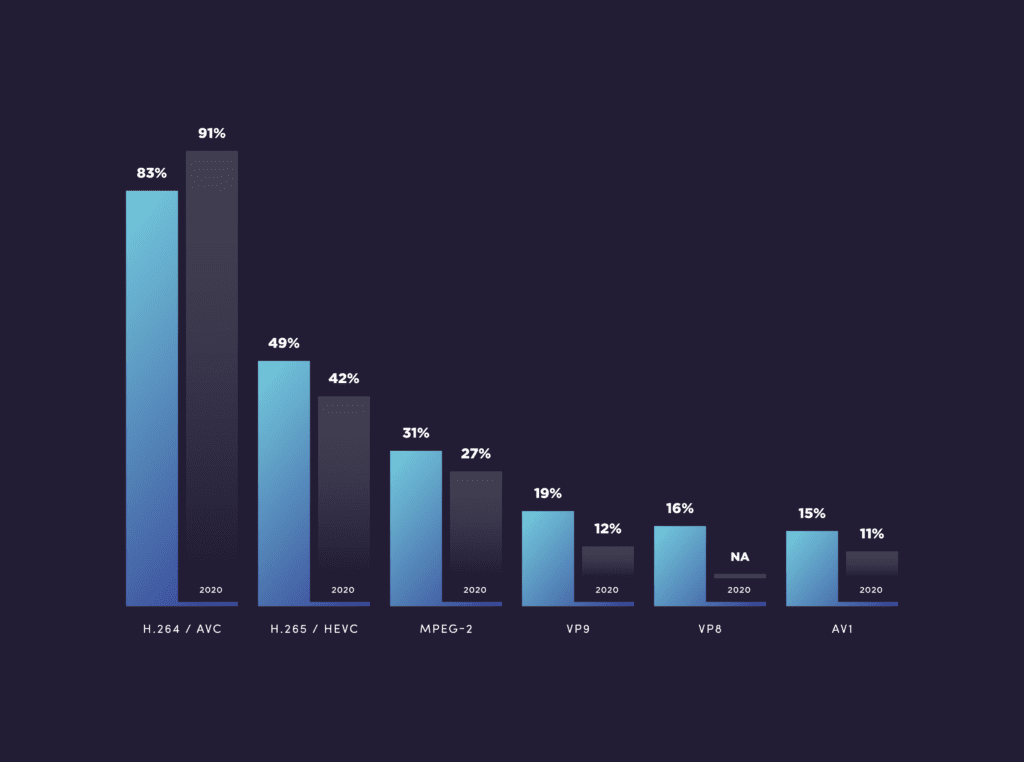
Perhaps a bit surprising, and may be an indication of accelerating adoption, the even more recent VVC is expected to be added into production by 20% of developers in the coming year.
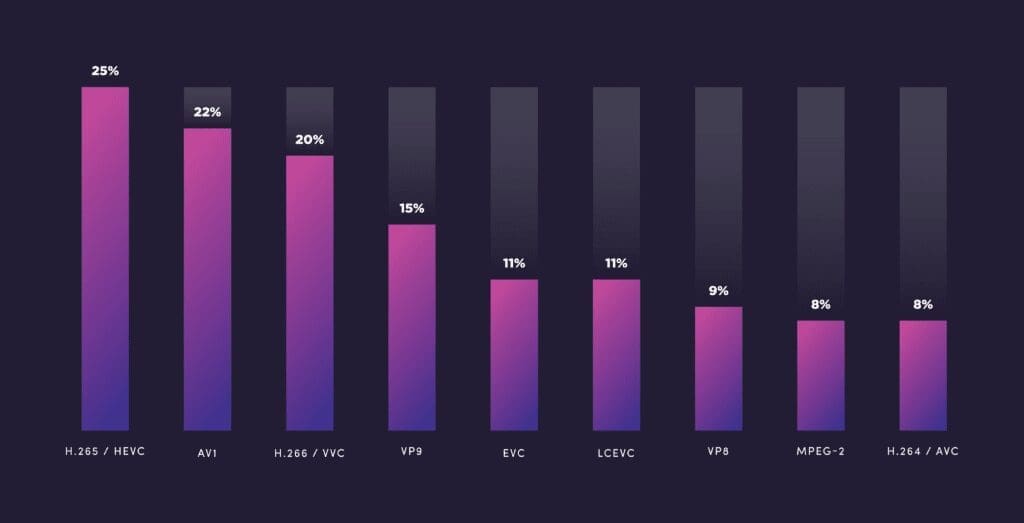
“If you’re looking for higher resolutions, higher refresh rates, higher bitrate content, and higher quality content (such as HDR), and all of those technologies in your codec is key to actually making that happen on your devices. This is where HEVC, AV1, and the gaining interest in VVC is coming into play” – Christian Feldmann @ Bitmovin Live
The trend towards AV1 and VVC adoption is further encouraged by the likes of Netflix, YouTube, Xiaomi, all launching increased support. So what does this mean for you? This means that a multi-codec approach is more important than ever and that any streaming-oriented organization should look into upgrading its compression workflows to match the demand for higher quality content, while simultaneously benefiting from overall cost reductions.
Video Technology Trend #3: Device Fragmentation is at an All-Time High
As has been the case for years now, the amount of devices the consumers can stream on is ever-growing, in fact, we’ve seen a full 10% increase in supported devices by video developers with no indication of slowing. The market for devices is more fragmented than ever before and OTT services need to be accessible anywhere and anytime.
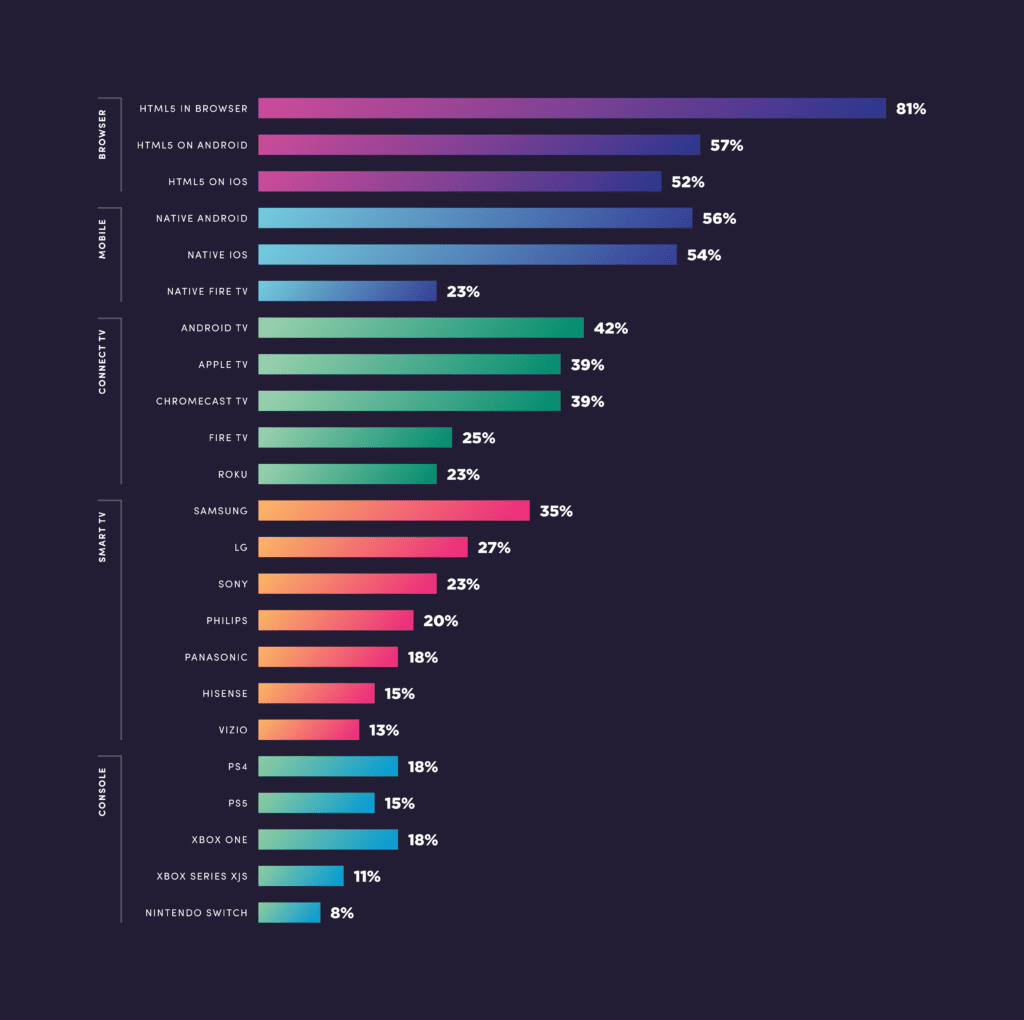
To reach all of these devices you need to carefully consider your content, audience type, and codec selection. While HTML5 on Browser remains the most popular, this is likely attributed to video consumption patterns during and away from work and may shift more towards mobile/TV consumption as people embrace remote working environments.
It’s also important to note that according to a report by Parks Associates, an average consumer will watch content across four unique devices on average, a further indicator that addressing such a fragmented market should be a top priority for streaming organizations.
Where device fragmentation is especially relevant is for streaming services that aim to reach a global audience, as consumers and developers alike have a variety of preferences based on their regions.
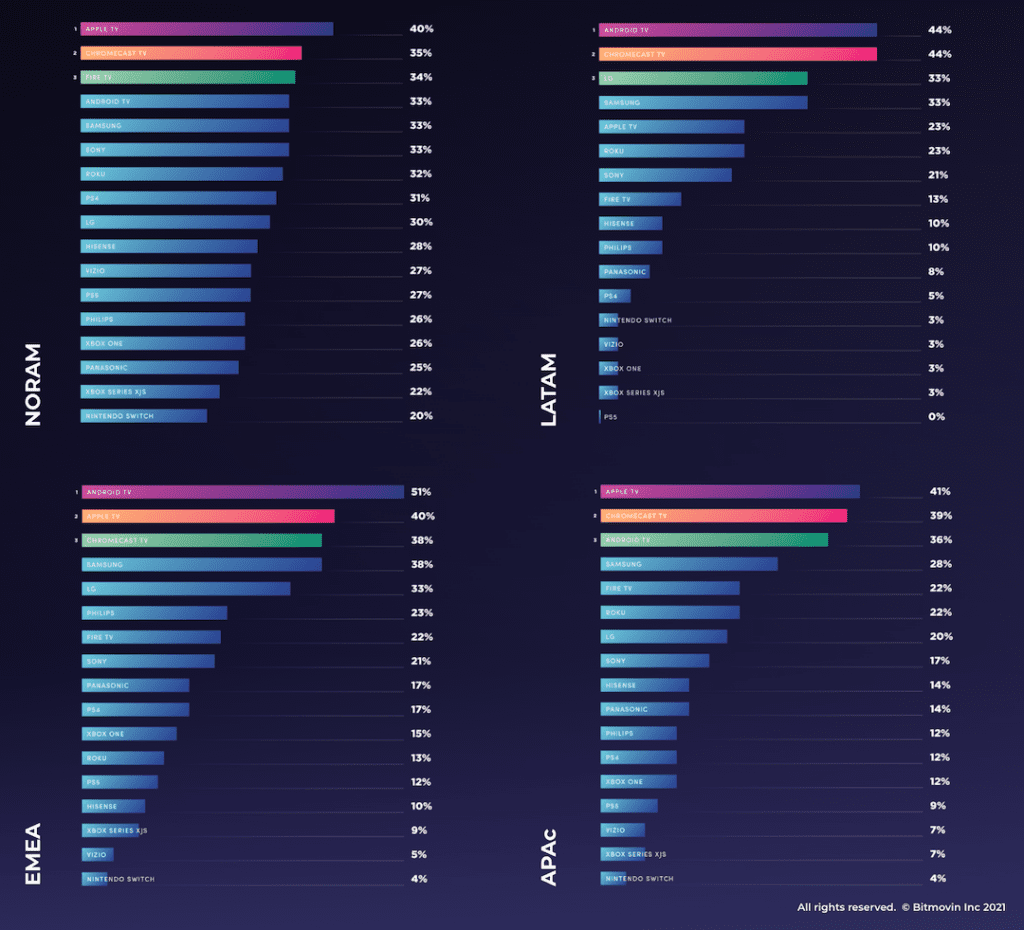
The most notable differences among devices are apparent amongst specific manufacturers, with Android TV, Chromecast, and Apple TV switching spots based on region – Apple leading in APAC and NORAM, with Android leading in EMEA and LATAM. Tying back to trend #2, organizations will want to consider their codec implementation strategy to help reach this freshly segmented device market.
Video Technology Trend #4: Granular Analytics is a Must-Have
Everyone knows data is important – we even had an “era” devoted to it. However, up until late 2021, video analytics had its limitations; namely, big data only focused on high-level attributes, such as impressions & video plays. The difference between big data and modern video analytics is how much organizations value granular data such as bitrates delivered, buffering, and error monitoring. According to Bitmovin’s latest video developer report, these video performance metrics make a major impact on how streaming service providers ensure that they deliver a high-quality viewer experience and reduce churn by quickly resolving/preventing any issues that arise.

With these granular metrics in mind, we’re also seeing an increase in the usage/application of video-specific analytics, as opposed to Google Analytics alone. While we’ve already addressed Why Google Analytics are not suitable for Online Video Analytics, it’s refreshing to see that developers agree, as GA usage has decreased from 52% to 37% between 2020 to 2021.

Although 39% develop in-house solutions (largely over security concerns), several commercial monitoring and analytics solutions are on the rise as more developers choose to focus on their own core products instead of applying the “let’s build it ourselves” mindset to video analytics.
How Can You Make the Most of These Video Technology Trends?
A lot is going on in the world of streaming video right now. While new codecs and low latency are huge opportunities, they’re also probably not the only thing on your plate. Make sure you capitalize on the trends that best serve your customers and your business. You don’t have to rework your business overnight, but if you ignore viewer engagement, you’ll face an uphill battle as the OTT landscape continues to evolve.
If you would like to try out Bitmovin’s Encoding, Player, and/or Analytics for your streaming solution, sign-up for a trial today.
More video technology guides and articles:
- Guide to the HTML5 Video Tag (Back to Basics)
- What is a VoD Platform?A comprehensive guide to Video on Demand (VOD)
- HEVC vs VP9: Modern codecs comparison
- Quality of Experience (QoE): Where Quality means doing it right when no one is watching (yet)
- Adaptive bitrate streaming: the technology designed to deliver video in the most efficient way possible and in the highest usable quality
- AVOD vs SVOD; the “fall” of SVOD and Rise of AVOD & TVOD (Video Tech Trends)




